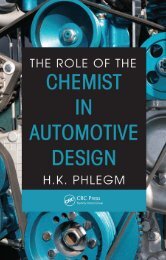Lightweight Electric/Hybrid Vehicle Design
Lightweight Electric/Hybrid Vehicle Design
Lightweight Electric/Hybrid Vehicle Design
Create successful ePaper yourself
Turn your PDF publications into a flip-book with our unique Google optimized e-Paper software.
Fig. 1.18 Gas turbine technology.<br />
Current EV design approaches 21<br />
1.3.7 HGV<br />
The heavy goods vehicle is an articulated truck which weighs 40 tonnes. Often omitted from clean<br />
air schemes on the grounds of low numbers they travel intercontinental distances every year and<br />
are major emitters of NO and solid particles. Their presence is felt where there are congested<br />
x<br />
urban motorways, and each one typically deposits a dustbin-full of carbon alone into the atmosphere<br />
every day, the industry declining to collect and dispose of this material! What is the solution? Use<br />
hybrid drivelines based on gas turbine technology; these vehicles would be series hybrids.<br />
A gas turbine/alternator/transistor active rectifier, Fig. 1.18, provides a fixed DC link of 500 V.<br />
This is backed up by a battery plus DC/DC converter. A battery of 220 V (totally insulated) is used<br />
for safety. High quality thermal management would be vital to ensure long battery life; 2 tonnes of<br />
lead–acid units would be needed (144 × 6 V × 110 Ah) to be able to draw 400 bhp of peak power.<br />
It is likely that capital cost would be offset by fuel cost savings. Another benefit is that the gas<br />
turbine can be multifuel and operation from LNG could be especially beneficial. The drive wheels<br />
are typically 1 metre in diameter giving 683 rpm at 80 mph. Usually there are 3:1 hub reductions<br />
in the wheels and a 2:1 ratio in the rear axle, giving a motor top speed of 4000 rpm. Translated into<br />
torque speed this means 2866 Nm at 1000 rpm, falling to 716 Nm at 4000 rpm. All motors are<br />
viable at this power; however, two factors dominate: (a) low cost and (b) low maintenance. DC<br />
brushed motors with 3000 hour brush life are unlikely contenders! PM brushless DC is unlikely<br />
on cost grounds, requiring 36 kg of magnets for 2900 Nm of torque. Both induction motors and<br />
switched reluctance are viable contenders but switched reluctance wins on efficiency and weight.<br />
The contenders are tabulated at Fig. 1.17(c).<br />
In the above review of four motor technologies for three vehicle categories, there is no clear<br />
winner under all situations but a range of technologies is evident which are optimal under specific<br />
conditions. Continuing development should improve the electronically commutated machines<br />
especially brushless DC and switched reluctance types. The relative success of these machines<br />
will be determined by improvements in magnet technology, especially plastic magnets, and cost<br />
reduction with volume of usage. On the device front, development is approaching a near ideal<br />
with 1/2 micron line width insulated gate bipolar transistors (40 kHz switching/l.5 V VCE saturated)<br />
but reduction in packaging cost must be the next major goal.<br />
1.4 Inverter technology<br />
Inverters are one area where progress is being made in just about every area 3 : silicon, packaging,<br />
control, processors and transducers. The task is to find a way down the learning curve as quickly<br />
as possible. Polaron believe the lowest cost will come from packaging motor and inverter as a<br />
single unit. The major development this year is that of reliable wire bond packaging for high







